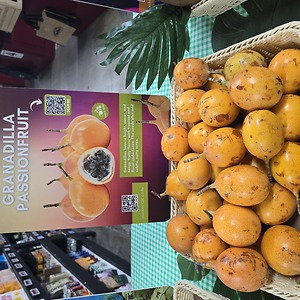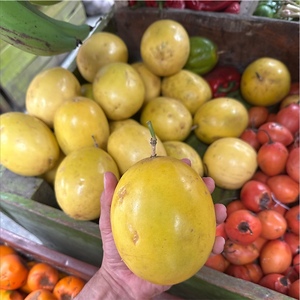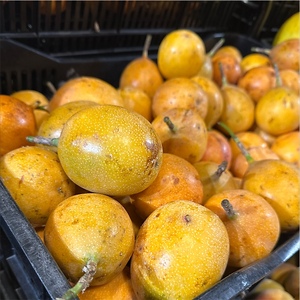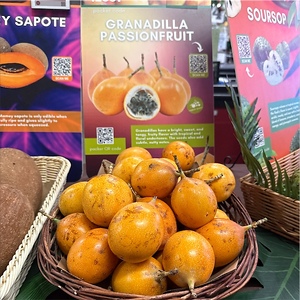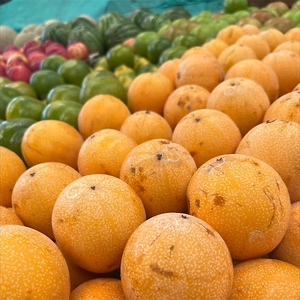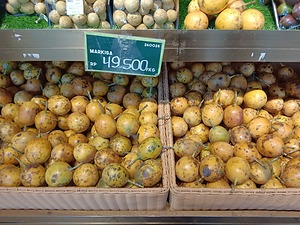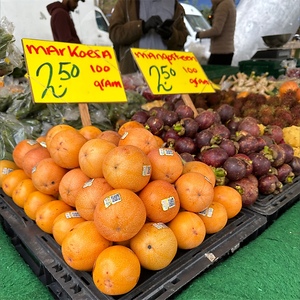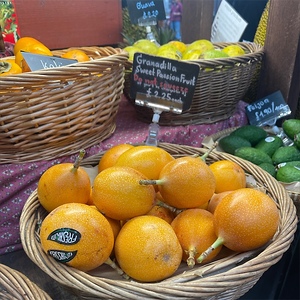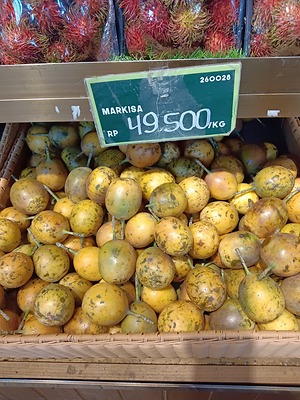

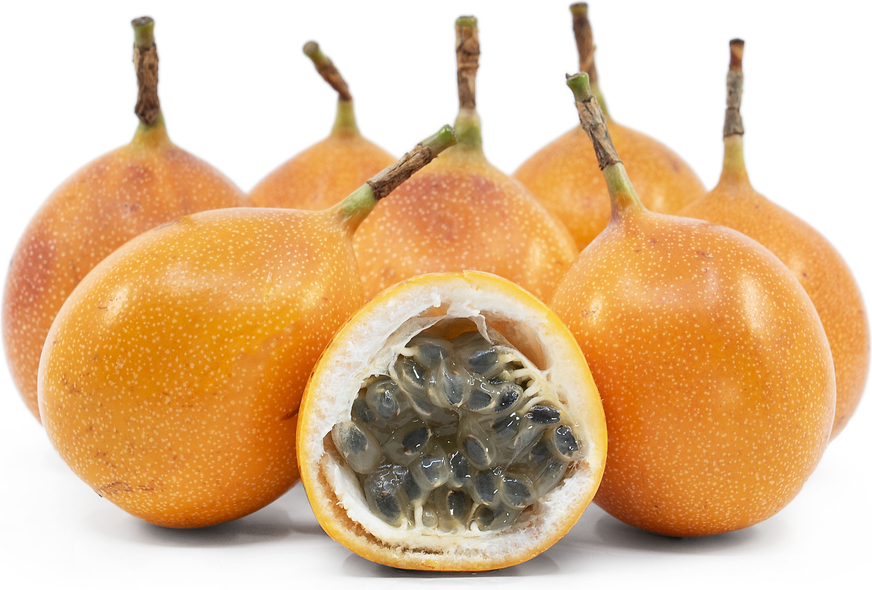
Granadilla Passionfruit
Estimated Inventory, lb : 0
This item was last sold on : 05/18/25
Description/Taste
Granadillas are small to medium fruits, averaging 6 to 8 centimeters in length and 3 to 5 centimeters in diameter, and have an elongated, oblong to oval shape with a hollow, lightweight feel. The rind is smooth, firm, and thick, initially green when young, darkening to an orange-yellow hue with maturity. It is important to note that the rind does not wrinkle, unlike purple passionfruit, and will remain smooth when ripe. The surface of the rind is brittle and can be easily cracked, sometimes covered in light tan to white specks. Underneath the outer shell, there is a layer of white, sticky, and spongy pith, encasing a mucilaginous, translucent pulp with many small, flat black seeds. The pulp is aqueous, slippery, and aromatic, while the seeds provide a crunchy consistency. Granadillas have a bright, sweet, and tangy, fruity flavor with tropical and floral undertones. The seeds also add subtle, nutty notes.
Seasons/Availability
Granadillas are available in the summer through fall.
Current Facts
Granadillas, botanically classified as Passiflora ligularis, are fruits of a climbing vine belonging to the Passifloraceae family. The sweet and tangy, seedy fruits are native to Central and South America and have become widely naturalized in tropical and subtropical regions worldwide. Granadilla is known by many names and spellings, including Sugar fruit, Sweet Granadilla, Granadia, Grandilla, and Granada China. The yellow-skin fruits are not as well-known as the purple passionfruit, but they are increasing in popularity, especially throughout Central America, for their mild nature. Granadillas are highly favored for their sweet, tropical taste and have become an exotic flavoring popularly incorporated into cocktails and desserts.
Nutritional Value
Granadillas are a good source of vitamins A and C, antioxidants that strengthen the immune system, reduce inflammation, and boost collagen production within the skin. The fruits are also high in fiber to regulate the digestive tract, provide phosphorus to assist in bone growth, and contain lower amounts of iron, potassium, and calcium.
Applications
Granadillas are best suited for raw applications as their sweet flavor and smooth, crunchy pulp is showcased when consumed fresh, out of hand. The brittle rind can be sliced or broken in half by hand, and the pulp can be scooped with a spoon and eaten raw. Granadilla pulp can also be poured over yogurt as a fresh topping, mixed into fruit salads, or incorporated into dressings. In addition to culinary applications, Granadilla pulp can be juiced and strained, mixing the sweet liquid into fruit drinks, cocktails, and smoothies. In Peru, Granadilla is frequently combined with orange or tangerine juice to create a sweet and tart breakfast juice. The pulp can also be made into jams and marmalades or used to flavor ice cream, sorbets, pies, pavlova, and cake frosting. Granadillas pair well with strawberries, blueberries, tangerines, blood oranges, limes, mascarpone, and yogurt. The fruits will keep 1 to 2 weeks when stored at room temperature and 2 to 4 weeks when stored in the refrigerator. The storage life of the Granadilla also largely depends on when the fruit was picked.
Ethnic/Cultural Info
When Spanish missionaries arrived in Central America in the 16th century, they were enthralled by the passionflower and saw Christian symbolism within the flower’s anatomical structure. Spanish missionaries believed the flower's appearance resembled icons of Christ's crucifixion, also known as the “Passion,” which was the period between the last supper and Christ’s death on the cross. The missionaries used these details on the flowers as visual symbols to share the crucifixion story with native peoples. Within the intricacy of the flower’s structure, the missionaries found the crown of thorns in the seventy-two filaments radiating from the blossom’s circumference, the five wounds Jesus suffered in his execution in the five stamens, and three stigmas represented the three nails that held him to the cross. After the missionary’s use of the flowers, the flowers became known as “Flor das Cinco Chagas” or the “Flower of The Five Wounds,” and were also named “Espina de Cristo” or “Christ’s thorn.” Eventually, the entire plant was generally labeled the passion plant, leading to the name passionfruit.
Geography/History
Granadillas are native to South and Central America and have been growing wild since ancient times. The vines thrive in elevations between 3,000 and 8,850 feet, especially in the Andes Mountains, and were introduced in the early 19th century to regions within the United States, Asia, and the Caribbean. Outside of their native region, Granadilla vines are sometimes labeled as an aggressive invasive species. Today Granadillas are available at local markets and specialty grocers in North America, Central America, South America, Asia, Southeast Asia, Africa, and Australia.
Recipe Ideas
Recipes that include Granadilla Passionfruit. One
| Keeper of the Kitchen |
|
Passion Fruit (Granadilla) Slice |
| Simply Delicious |
|
Granadilla Passion Fruit Crud |



